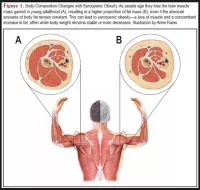What is Sarcopenic Obesity?
Sarcopenia is the technical term for a low muscle mass (from the Greek for ‘poverty of flesh’) and usually refers to a loss of mass in the major skeletal muscles. This can be caused by a variety of medical conditions ranging from rare inherited disorders to a simple atrophy through insufficient use of the muscles. Sarcopenic Obesity (SO) describes the condition in which obesity co-exists with sarcopenia. In the absence of specific clinical conditions there are two main causes of muscle loss: inactive lifestyles and ageing. These same conditions tend to lead to obesity and, since both are common in the modern world, SO is rapidly emerging as a major health issue.
Why does Sarcopenic Obesity Matter?
Muscle is beneficial to health in many ways. For example, fit muscles help create a virtuous cycle of active lifestyles, and healthy muscles aid independence in the elderly and protect them from life-threatening falls and fractures. Sarcopenic Obesity is of particular concern to metabolic health where it creates a double jeopardy. Fat and muscle have opposing effects on glucose sensitivity and hence the ratio of the two masses is an important determinant of metabolic health especially in relation to insulin resistance and the associated metabolic syndrome. Muscle utilizes glucose whereas the fatty acids derived from excess adipose tissue inhibit the utilization of glucose; hence the double jeopardy.
The Importance of Maintaining a Healthy Muscle Mass
Muscle mass and function vary over a wide range within any population group even excluding the extreme ends of the spectrum represented by muscle disease at one end and elite athletes at the other.
In young children a healthy muscle mass and motor development supports participation in play and sports that can entrain a lifelong love of recreational physical activity that is so important in maintaining metabolic health in the modern obesogenic environment.
In adulthood a gain in the proportion of fat mass to muscle mass reduces a person’s power-to-weight ratio and makes everyday tasks, such as climbing stairs, more difficult. This creates a downward cycle in which a reluctance to take exercise (for instance, choosing to use escalators and elevators instead of stairs) encourages a further gain in body fat and a deterioration in metabolic health.
In the elderly, a healthy muscle mass is essential to maintain mobility, everyday functions and quality of life. It is especially important in maintaining good balance and hence avoiding the falls and fractures that contribute greatly to ill-health and death among older people.
Body Composition Monitoring
Devices that monitor and track body composition can be beneficial in analyzing the ratio of muscle and fat within the body. One type of device for doing this is Bioelectrical Impedance Analysis (BIA) scale. BIA assesses body composition by passing a very small current through the body and assessing differences in impedance caused by the fact that fat and lean tissues have different electrical properties. Models that employ both hand and foot electrodes will provide a segmental analysis, offering a practical means of assessing appendicular skeletal muscle mass and body fat.



Comments